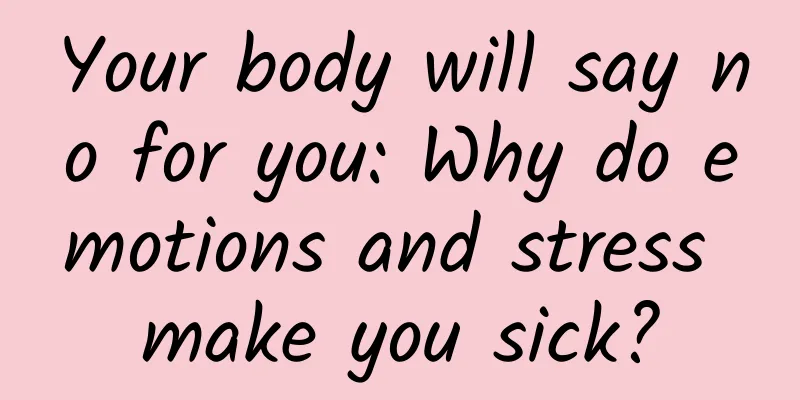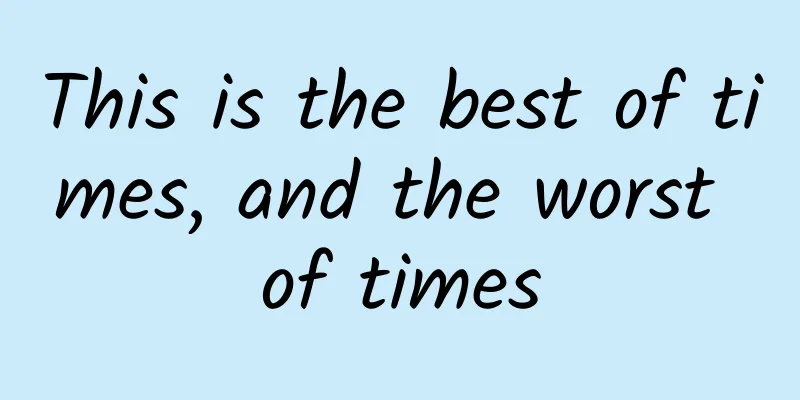Your body will say no for you: Why do emotions and stress make you sick?

|
Over the centuries, many doctors have come to realize that emotions strongly influence the development and recovery of illness. They have challenged mainstream medical concepts through research and writing, but these ideas, explorations and insights have repeatedly disappeared in the "Bermuda Triangle" of medicine. The understanding of the mind-body relationship by generations of doctors and scientists has disappeared without a trace before it has been understood by the public. Now, a new science of mind-body interaction, psychoneuroimmunology, is trying to study the intimate interaction between the mind (thinking and emotions) and the nervous system at the cellular level, and how both are closely linked to immune defense. This article is excerpted from "Your Body Will Say No for You" (June 2023 edition, Mechanical Industry Press), and the title is given by the editor. Written by Gabor Maté Translation | Li Hanjie, Hou Can, etc. Mary is a female patient I have treated for 8 years. She is in her early 40s, a local, thin, gentle and modest. She is married with 3 children. She loves to laugh, but her smile is full of shyness and lack of confidence, which is unforgettable. Whenever her smiling face appears in my mind, I always feel warm in my heart, but when I think of the pain she has suffered, my heart is tightly gripped. An illness took her life. The initial condition seemed simple: a needle prick on her finger that did not heal for several months. Unfortunately, it was Raynaud's phenomenon, which is the narrowing of the small arteries supplying blood to the finger, causing tissue hypoxia and gangrene. Mary was repeatedly hospitalized and underwent surgery within a year. Because the pain was too severe, she required amputation, but after the amputation, her condition continued to worsen, and even the strongest anesthetics could not relieve the severe pain. Raynaud's phenomenon sometimes occurs alone or in combination with other diseases. Smokers are at higher risk for this disease, and Mary had been a frequent smoker since she was a teenager. She tried to quit smoking again and again, but blood circulation in her fingers did not return to normal. Raynaud's phenomenon was just a precursor to something worse: Mary was later diagnosed with scleroderma, an autoimmune disease. Autoimmune diseases include rheumatoid arthritis, ulcerative colitis, systemic lupus erythematosus, and many diseases that have not been considered autoimmune diseases, such as diabetes, multiple sclerosis, and even Alzheimer's disease. What these diseases have in common is that they are caused by the body's own immune system attacking organs. These attacks cause damage to joints, connective tissue, and even many organs, which may be eyes, nerves, skin, intestines, liver, or brain. Scleroderma is a "suicidal" attack by the immune system, which causes hardening of tissues such as the skin, esophagus, heart, and lungs. What exactly caused this body's civil war? Medical textbooks explain diseases entirely from a biological perspective, believing that a small part of the disease is caused by toxins in the body, but the biggest influencing factor is genetic susceptibility. This mindset of focusing only on the body is even more obvious in medical practice. Whether as an expert or as a family doctor, I never considered the impact of her special life experience and her mental state before the illness on the course and outcome of the disease. Instead, I simply treated the physical symptoms themselves: let her take anti-inflammatory and analgesic drugs, perform surgery to remove gangrene and improve blood circulation, and perform physical therapy to restore mobility. Suddenly one day, a strong intuition flashed through my mind: Maybe Mary needs to be listened to. So I met with her for an hour and asked her to tell her story. What she said revealed everything. Under her gentle and timid appearance, there are a lot of repressed emotions. Mary was abused and abandoned as a child, and was transferred to different foster families. The scene when she was 7 years old was deeply imprinted in her mind: young Mary curled up in the corner of the attic, hugging her sisters tightly, and the drunk foster parents downstairs were shouting and cursing. "I was so scared," she said, "I have to protect my sisters, but no one will protect me." She never mentioned these traumas even to her husband of 20 years. She learned from an early age not to express any feelings to anyone, including herself. Expressing herself, showing vulnerability and questioning were all risky behaviors for her as a child. She felt safe only when she considered others and not herself. Mary was forced to take on the responsibility of protecting others when she was a child, and she still can't get out of it now. She never realized that she also has the right to be cared for, listened to and cared about. Mary described herself as someone who had no ability to say "no" and who forced herself to take responsibility for the needs of others. Even as she became terminally ill, her primary concern was her husband and her growing children. Was scleroderma her body's ultimate rebellion against her endless sense of responsibility? Perhaps Mary’s body was doing what her mind could not: letting go of the expectation to always put others before herself—an expectation imposed on her as a child and on herself as an adult. “When we can’t learn to say no, our bodies end up saying it for us,” I wrote about Mary’s situation in my first medical column for The Globe and Mail in 1993, citing medical literature discussing the negative effects of stress on the immune system. The idea that emotional coping might be a factor in chronic diseases like scleroderma angered many doctors. A Canadian rheumatologist wrote a letter to the editor scathingly condemning my article and its publication, criticizing my lack of experience and my lack of research. It’s not surprising that experts would ignore the connection between mind and body. Our understanding of health and disease has long been influenced by dualism, the desire to split the mind-body whole into two. We want to understand the body in isolation from the mind, and thus describe health and other aspects of human beings as if they were formed independently of the environment in which we grow, live, work, play, love, and die. Most doctors are trained to think this way and apply it to their practice. Unlike many other disciplines, medicine has not yet learned the valuable lesson of Einstein's theory of relativity: the location of the observer affects the observed phenomenon, which in turn affects the results of the observation. Hans Sely, a pioneer in stress research and a Czech-Canadian scholar, once pointed out that scientists' unverified assumptions can determine the results of their discoveries, but also limit their discoveries. He wrote in "The Stress of Life": "Most people do not fully realize how much the spirit of scientific research and the lessons learned from it depend on the personal perspective of the discoverer. In this era that relies so much on science and scientists, this basic issue needs to be paid attention to." As a doctor, Sely frankly exposed this phenomenon, but even more than 20 years later, few people can understand his words now. The more specialized the doctor, the more in-depth his or her study of a particular part or organ of the body becomes, making it difficult for him or her to understand the person as a whole. Many of the patients I interviewed while writing this book almost unanimously said that specialists and family doctors had rarely asked them to explore their subjective feelings about life; even if they did, they were not encouraged to communicate these feelings with their doctors. When I talked to my specialist colleagues about their patients, I found that even after years of doctor-patient relationships, many of them did not understand the patient's life and experiences beyond the disease. In this book I will focus on the effects of stress on health, especially those that develop early in life, which are so deeply and cleverly hidden that they seem to be part of our true self. I will try to present the scientific evidence I have collected, but it is more important for me to share with readers those unique personal experiences, which may be considered "anecdotal" by many people and not convincing. Only a Luddite would deny the enormous benefits that rigorous application of the scientific method has brought to humanity. But experimental research or statistical analysis cannot verify all necessary information. We cannot reduce all aspects of disease to facts that can be verified through double-blind studies and the most rigorous scientific methods. Ivan Ilyich wrote in Limits to Medicine: "Medicine cannot fully represent the meaning of healing, suffering, and death, just as chemical analysis cannot describe the artistic value of pottery." If we do not accept the experience and insights of the human race, we will limit ourselves to a narrow range of knowledge. We have missed something valuable. William Osler, one of the greatest doctors of all time, suspected in 1892 that rheumatoid arthritis (related to scleroderma) was a stress-related disorder. Despite the scientific evidence that has supported his view in the 110 years since his article was published, modern rheumatology has all but ignored it. This narrow scientific approach guides the practice of medicine. We are too quick to discard the insights of our predecessors and to place modern science on such a high pedestal that it becomes the arbiter of our fate. American psychologist Ross Buck pointed out that before the development of modern medical technology and pharmacy, most doctors relied on the "placebo effect". They needed to convince each patient that they could recover. In order for the treatment to be effective, the doctor had to listen to the patient, establish a good doctor-patient relationship, and trust his or her intuition. Today's doctors have lost this ability and rely almost entirely on "objective" measurements, diagnostic techniques, and "scientific" treatments. It seems that the rheumatologist's accusation against me was not unexpected. But what was shocking was that a few days later, the editor received a letter of support from Noel B. Hershfield, a professor of clinical medicine at the University of Calgary. The letter read: "The emerging field of psychoneuroimmunology has matured, and more and more scientists from different fields have demonstrated that the brain and the immune system are closely related... People's emotional temperament and response to persistent stress may cause many medically treatable but unknown diseases, such as scleroderma, most rheumatic diseases, inflammatory bowel disease, diabetes, multiple sclerosis, and a large number of other diseases that appear in every medical specialty..." The letter unexpectedly revealed a new field of medicine: psychoneuroimmunology . As I understand it, it is the science of the mind-body interaction, the inseparable unity of emotion and body in human development and in health and disease throughout life. It may seem a complicated term, but it is actually easy to understand: this discipline studies the intimate interaction between the mind (thinking and emotions) and the nervous system, and how both are closely linked to immune defense. Some people also call it psychoneuroimmunoendocrinology, to indicate that endocrine or hormones are part of the body's overall response system. Emerging research is trying to reveal how this system works at the cellular level. These new discoveries are based on knowledge that we have long known but have forgotten. Over the centuries, many doctors have come to realize that emotions strongly influence the development and recovery of illness. They have challenged mainstream medical ideas through research and writing, but these ideas, explorations and insights have repeatedly disappeared in the "Bermuda Triangle" of medicine. The understanding of the mind-body relationship by generations of doctors and scientists has disappeared without a trace before it can be understood by the public. In 1985, an editorial in the prestigious New England Journal of Medicine declared imperiously: “It is time to admit that the view that illness is a direct reflection of psychological states is nothing more than folklore.” Such an assertion is obviously untenable. As Dr. Hirschfield wrote in his letter to the Globe and Mail, although psychoneuroimmunology has not yet entered the field of medical practice as an emerging discipline, it has begun to gain recognition. A quick browse through a medical library or the Internet will reveal the developments in this emerging field in papers, journals, and textbooks. Much of the information has been disseminated widely through popular books and magazines. The general public is actually ahead of the professionals in many ways. They are not constrained by the inherent orthodoxy and are more receptive to the idea that people cannot be simply divided and that the human organism is more than a simple combination of its parts. Our immune systems are closely tied to our daily experiences. For example, healthy young people have functioning immune defenses, but research shows that medical students stressed by final exams have suppressed immune defenses. Loneliness has the greatest negative impact on students’ immune systems, even to the point of affecting their future health and well-being. A study of a group of inpatients with schizophrenia also showed that loneliness was significantly associated with reduced immunity. Even without further research evidence (and there is plenty), we must consider the long-term effects of chronic stress. Exam stress is short-term and obvious, but many people spend their lives facing a powerful, demanding examiner who must be pleased at all costs. Many people, while not lonely, live in emotionally deprived relationships that fail to recognize or respect their deepest needs. Emotional isolation and stress can affect many people, even if they feel their lives are good enough. How does stress turn into disease? Stress is a complex chain of physical and biochemical reactions that occur when people face strong emotional stimulation. From a physiological point of view, emotions themselves are the release of electricity, chemicals and hormones in the human nervous system. Emotions affect the function of major organs, the integrity of immune defenses, the systemic circulation of biological substances, etc., which in turn affect emotions. Just as Mary had to seek protection in her childhood, this suppression of emotions will disarm the body's defenses against disease. Repression separates emotions from consciousness and places them in the unconscious realm, which disrupts and confuses our physiological defenses, so the defenses that are supposed to protect the body go wrong and become destroyers of health. During my seven years as a medical coordinator in palliative care at Vancouver Hospital, I encountered many chronic illness patients whose emotional experiences were very similar to Mary’s. Patients who came to us for treatment of cancer or neurodegenerative processes such as amyotrophic lateral sclerosis presented similar dynamics and coping styles. In my private family practice, I also encountered a wide range of diseases: multiple sclerosis, inflammatory bowel diseases such as ulcerative colitis and Crohn’s disease, chronic fatigue syndrome, autoimmune diseases, fibromyalgia, migraines, skin diseases, endometriosis, and more. I observed the same pattern in these patients: almost all of the seriously ill patients had not learned to say “no” in important areas of their lives. Although on the surface, many people’s personalities and situations are very different from Mary’s, the underlying emotional repression is a pervasive factor. I had a terminally ill middle-aged male patient who was the president of a company that sold shark cartilage for cancer treatment. When he was admitted to the palliative care unit, the cancer had spread throughout his body. He continued to take shark cartilage until he died, even though he didn't believe it really worked. Shark cartilage smells bad, and you can smell the pungent smell even from a distance, let alone eat it. "I hate it," he told me, "but if I don't take it, my partner will be very disappointed." I advised him, "You have the right to stop being responsible for the disappointment of others and just live your last moments well." I think it's a sensitive issue that people's lifestyle habits may cause them to get sick. In the case of smoking and lung cancer, the link between behavior and disease is obvious. But when it comes to emotions and multiple sclerosis, breast cancer, or arthritis, the connection is harder to prove. While suffering from the disease, patients are also offended by "who they are." A 52-year-old university professor who was being treated for breast cancer asked me, "Why did you write this book? I got cancer because of my genes, not because of anything I did." “We should not blame patients and view their illness and death as personal failures,” a 1985 editorial in the New England Journal of Medicine stated. “When patients are troubled by their illness, they should not be burdened with the responsibility for the consequences.” We will return to this vexing question of supposed blame later. At this point I will simply point out that blame and failure are not the problem. Such talk is merely confusing. As we will see, blaming the patient, in addition to being morally flawed, is scientifically unfounded. The NEJM editorial confuses blame with responsibility. While we all hate being blamed, we all want to be more responsible, that is, to be able to consciously respond to our life circumstances rather than just react. We want to be the authority over our own lives: to take responsibility and be able to make responsible decisions that affect us. Responsibility without awareness is not real responsibility. One of the greatest weaknesses of the Western medical approach is that it sees the doctor as the only authority, and the patient is often just the recipient of treatment or cure. People are deprived of the opportunity to take real responsibility. When we succumb to illness and death, we certainly have no reason to be blamed. Anyone can be overwhelmed by illness at any time, but the more we understand ourselves, the less we can become passive victims. We need to consider the connection between body and mind not only in understanding illness, but also in understanding health. Dr. Robert Maunder, who teaches in the Department of Psychiatry at the University of Toronto and has written about the mind-body connection in relation to illness, told me in an interview, “It is more beneficial to your health to try to identify and address the issues that come with stress than to ignore them.” In the healing process, every bit of information, every bit of truth, can be crucial. If there is a connection between emotions and physiology that is not being made public, people are missing out on a powerful therapeutic tool. Here we are faced with a lack of language. Even to discuss the connection between body and mind implies that two unrelated entities are somehow connected to each other. Yet in life there is no such separation: there is no body without mind, and no mind without body. Therefore, some have suggested using the term "mindbody" to capture this real state. In the West, the idea of the unity of mind and body did not appear late. In one of Plato’s dialogues, Socrates quoted a Thracian’s criticism of his Greek colleagues: “This is why Greek doctors do not know how to cure so many diseases, they know nothing about the whole. This is the biggest mistake made in human treatment today, that is, to separate the mind from the body.” As early as 2,500 years before the emergence of psychoneuroimmunoendocrinology, Socrates proposed that we cannot separate the mind from the body! I wrote this book not only to consolidate insights I had originally developed in my article about Mary's scleroderma. I have learned a great deal and am deeply indebted to the hundreds of physicians, psychologists, and researchers who have mapped the mind and body as it has never been mapped before. The process of writing this book was also an exploration of my own repressed emotions. I began this journey of self-discovery in response to a question from a counselor at the British Columbia Cancer Agency while investigating the role of emotional repression in cancer. Many patients with malignancies seem to have an automatic denial of psychological and physical pain, as well as of uncomfortable emotions such as anger, sadness, and rejection. "What is your personal connection to this problem?" the counselor asked. "What interests you so much about this topic?" This question reminds me of an evening seven years ago when I visited my 76-year-old mother in a nursing home. She suffered from amyotrophic lateral sclerosis, a muscle-wasting disease that ran in our family. She could only sit up with help, so she could no longer live at home. Her three sons and other relatives visited her regularly in the nursing home until she died—when I started writing this book. Back to the story. I had surgery that morning for a torn cartilage in my knee, so I walked with a limp when I went to the nursing home. This was the result of ignoring the pain that my body reminded me every time I jogged on the concrete. The moment I opened my mother's door, I automatically walked to her bedside and greeted her with a normal gait as if nothing had happened. This sudden thought to hide my limp was not a conscious one, and my action happened before I was aware of it. Later I began to wonder what prompted me to take such an unnecessary action. I say unnecessary because my mother should be calm about her 51-year-old son limping for 12 hours after knee surgery. So what was going on? Even in such a harmless situation, my impulse to protect my mother from pain was a deeply ingrained instinctual response that had little to do with what either of us needed at the time. This repression was a memory, a dynamic reenactment, etched into my developing brain before I was aware of it. As a child, I survived the Nazi genocide. I spent most of my first year in Nazi-occupied Budapest. My maternal grandparents were murdered in Auschwitz when I was five months old. My aunt was deported and never heard from again. My father was in a forced labor camp serving the German and Hungarian armies. My mother and I lived in the Jewish ghetto of Budapest. There were weeks when she had to leave me alone to save me from starvation or disease. It doesn’t take much imagination to understand that under this inhuman daily stress, my mother rarely had the gentle smile or undivided attention that a developing baby needs to feel secure and unconditionally loved. In fact, my mother told me that there were times when she felt so desperate that caring for me was the only thing that got her out of bed. At an early age, I realized that I had to fight for attention while adding as little burden to my mother as possible, and it was best to suppress any anxiety and pain. In a healthy mother-infant relationship, the mother nurtures her child unconditionally, without the child having to make any effort. My mother failed to provide me with this unconditional care. She was not a saint or perfect, so even if our family had not lived in such a horrible environment, she would probably not have been completely successful in doing so. In this situation, I became my mother's protector - first of all, protecting her from the awareness of my pain. What started as an automatic infantile defense mechanism soon developed into a fixed personality trait. Fifty-one years later, I still have to hide the slightest physical discomfort from my mother. I had never considered approaching the topic of "your body saying no" at this level. This opened up an intellectual exploration of theories that could help explain human health and disease. Although this is an area that has been explored by others, there is always more to explore. The counselor's questioning made me confront the issue of emotional repression in my own life. I realized that hiding my limp was just one small example. So in this book, I not only draw on what I have learned from others and academic journals, but I also describe what I have learned from my own experience. This mechanism of repression exists in all of us. We are all self-deniers and self-betrayers to some extent. Most of the time we are not aware of it, just like I was when I "decided" to cover up my lameness. Being healthy or sick is a matter of degree, and of various contributing factors, such as genetics or environmental factors, that need to be considered. So when I suggest that repression is a major source of stress and a major contributor to illness, I am not trying to blame others for “making themselves sick.” I wrote this book to promote learning and healing, not to add to the blame and shame that is already rampant in our culture. Maybe I am a little overly sensitive about blame, but most people are. Shame is the deepest of negative emotions, and it is something we try to avoid at almost any cost. Unfortunately, our constant fear of shame undermines our ability to see reality clearly. Despite the best efforts of many doctors, Mary died in a Vancouver hospital eight years after her diagnosis from complications of scleroderma. Although her heart was very weak and her breathing was weak, Mary still kept a gentle smile until the end of her life. Every once in a while, she would ask me to arrange a long private visit, just to chat about everything big and small. She once said that I was the only one who listened to her. I sometimes wonder what Mary's life would have been like if someone had been there to hear her, see her, and understand her when she was an abused, frightened child who felt responsible for her little sister. Maybe, if someone had been there consistently, she could have learned to value herself, to express her feelings, to express her anger when people pushed her boundaries, physically or emotionally. Would she be okay today if that had been her fate? About the Author Gabor Maté is a well-known Canadian doctor and writer, and recipient of the Order of Canada, Canada's highest civilian honor. Maté has worked as a general practitioner and palliative care physician in several Vancouver hospitals for decades. He is known for his focus on patients' psychological problems and helping them heal through in-depth conversations with them. Special Tips 1. Go to the "Featured Column" at the bottom of the menu of the "Fanpu" WeChat public account to read a series of popular science articles on different topics. 2. Fanpu provides a function to search articles by month. Follow the official account and reply with the four-digit year + month, such as "1903", to get the article index for March 2019, and so on. |
<<: Why can’t we always let go of “dreams”?
>>: If your body shows these 3 high-risk signs, it means you are really too tired!
Recommend
How does Shanda Games achieve automatic management of remote servers?
This article is the on-site dry goods of WOT2016 ...
Anti-cancer and anti-cancer, the "anti-inflammatory diet" teaches you how to eat! But many people can't do the last one
If you don’t eat right, low-level inflammation in...
People's Daily: The cryptocurrency craze should be cooled down. Don't lose your mind just because someone got rich overnight.
Following the release of a risk warning to preven...
Yizhuo.com’s product removal phone number is unreachable: the money-burning model of fresh food e-commerce is difficult to sustain
During this period, Ms. Liu, a citizen, found tha...
Taking advantage of the Big Snow solar term, these 19 brand inspirations are worth a look!
The Big Snow solar term is coming This name is a ...
A thousand-yuan phone also has a fingerprint "big trick" Dashen Note3 hands-on experience
Redmi, Meizu Blue, Honor Play, Lenovo Lemon... Do...
How can Weibo advertising take advantage of the epidemic to revive?
“If you were given a room with a suitable tempera...
8 interesting facts about WeChat, each of which is super useful! A step-by-step guide to help you master WeChat
01Create WeChat group There are more and more fri...
When will electric cars be cheaper than fuel cars? Technological progress and economies of scale will be key factors in reducing costs
my country has 2 million new energy vehicles, but...
More than three years later, the loving penguin dads are still together!
Almost all of the young penguin lovers at a Sydne...
This vegetable, which many people love to eat, is really not recommended to be eaten with rice, because...
Potatoes are a classic "side dish" that...
Apple Pay enters China: UnionPay’s first step in turning around mobile payments
[[129850]] The red envelope war during the Spring...
Why did ocean oxidation take 2 billion years to complete? The key lies in this huge “reservoir” →
Oxygen is the source of life. The oxygen content ...
A sudden landslide in Sichuan has caused more than 30 people to lose contact! How to avoid disasters scientifically?
At around 11:50 on February 8, a landslide occurr...
China Mobile's own-brand 4G mobile phone: a whip on the manufacturer
China Mobile decided to reduce or even stop fixed ...









